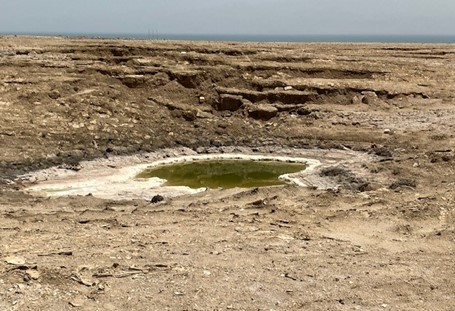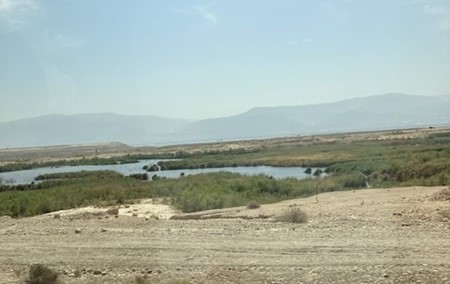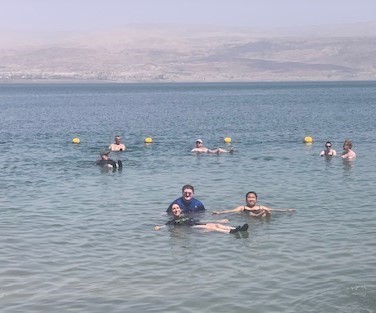Day Ten – Livin' It Up at the Dead Sea
By: Genene Adams '24
This article is part of a series of reflections prepared by students enrolled in the Texas A&M School of Law 2023 Global Field Studies Program: Israel. Click here to visit the entire series.
Having never been to Israel before, there was much on our group’s full agenda that filled me with excitement. One experience I looked forward to most, though, was our trip to the Dead Sea, and it did not disappoint! Located at the top of the list for tourists visiting Israel, this may not come as a surprise. However, in addition to floating in the Dead Sea, other things I saw and learned that day were interesting and enlightening.
Dead Sea
Dr. Clive Lipchin, director of the Arava Institute's Center for Transboundary Water Management, led the tour of the arid region. Our first stop was atop a hill with a panoramic view of not only the Dead Sea but also the Dead Sea Works, a company that extracts many of the sea’s valuable minerals. Notably, 20-30% of the sea’s evaporation is due to Dead Sea Works. Dr. Lipchin informed us that freshwater does in fact make its way to the Dead Sea via the Jordan River, but the fresh water does not have anywhere to go from there because it—the Dead Sea—is the lowest land point on Earth. High temperatures combined with evaporation of that fresh water are big reasons why the Dead Sea is so salty.

Dead Sea Works
Beyond just being salty, the Dead Sea contains a rich makeup of chemicals. Pot ash, which is converted to fertilizer, is one of the most valuable. Extracted through Dead Sea Works, the whole operation is a hugely profitable business. And with 3,000–4,000 employees, it is a massive source of employment for residents of southern Israel. One fun fact Dr. Lipchin provided about Dead Sea pot ash is that its natural color is white, but the extracted pot ash is dyed red because that is what customers want and expect.

White pot ash (left) dyed red (right) by Israel Chemicals Ltd. (ICL) & Dead Sea Works (a subsidiary of ICL)
Our next stop was dry land by the road—land that was filled with water 50 years ago—to get a close-up of large sinkholes. The way these sinkholes are formed is quite interesting. Notably, the Dead Sea itself continues to recede. As that happens, underground saltwater adjacent to the Dead Sea does the same, which leaves salt deposits behind. Fresh groundwater on the outer edges of the region then dissolves those salt deposits, creating underground cavities where the salt deposits had been. Once the unsupported ground above such a cavity collapses, a sinkhole is formed.

One of many sinkholes Dr. Lipchin showed us
Roughly 10,000 sinkholes currently exist along the Dead Sea region (a growing concern as more continue to form). Surprisingly, as the sinkholes get bigger and bigger, some actually make groundwater visible. And this less salty water then creates its own small ecosystem! For a place with such a morbid name, the last thing I expected to see anywhere around the Dead Sea was thriving vegetation, but we passed a few wetland oases on the bus ride toward our last and most anticipated stop: the shore of the Dead Sea.

Wetlands we passed during our tour of the Dead Sea Region
Floating in the Dead Sea was the coolest experience of the whole trip for me. I had never experienced anything like it before. Living in a world where gravity always pulls you down, it was so neat to walk deeper into the Dead Sea and feel the water want to hold you up. By the time I was waist-deep in the water, the slightest lift of my legs brought me directly to the water’s surface, and I was floating horizontally within what seemed like a mere millisecond! I was still floating even as I drifted to the very shallow parts to lather myself with the Dead Sea mud—something you must try if you ever visit the Dead Sea. Many of us were skeptical of the “healing powers” we heard about this mud, but we were all amazed at how soft our skin was after rinsing it off. My skin had never felt smoother!

Caleb, Tiana, and I enjoying our time in the Dead Sea
We had quite an array of experiences during our time in Israel, and I am grateful to have been along for the ride. However, if I ever go back, you will probably find me living it up at the Dead Sea!
Learn more about Texas A&M University School of Law's Global Law and Policy Program, Aggie Dispute Resolution Program, and Energy, Environmental, and Natural Resource Systems Law Program
